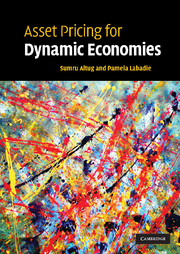Book contents
- Frontmatter
- Contents
- List of figures
- List of tables
- Preface
- I BASIC CONCEPTS
- II RECURSIVE MODELS
- 6 Dynamic programming
- 7 Intertemporal risk sharing
- 8 Consumption and asset pricing
- 9 Non-separable preferences
- 10 Economies with production
- 11 Investment
- 12 Business cycles
- III MONETARY AND INTERNATIONAL MODELS
- IV MODELS WITH MARKET INCOMPLETENESS
- V SUPPLEMENTARY MATERIAL
- Bibliography
- Index
12 - Business cycles
Published online by Cambridge University Press: 01 June 2010
- Frontmatter
- Contents
- List of figures
- List of tables
- Preface
- I BASIC CONCEPTS
- II RECURSIVE MODELS
- 6 Dynamic programming
- 7 Intertemporal risk sharing
- 8 Consumption and asset pricing
- 9 Non-separable preferences
- 10 Economies with production
- 11 Investment
- 12 Business cycles
- III MONETARY AND INTERNATIONAL MODELS
- IV MODELS WITH MARKET INCOMPLETENESS
- V SUPPLEMENTARY MATERIAL
- Bibliography
- Index
Summary
The notion that economies are subject to recurring fluctuations dates back to Kondratiev [283]. In his framework, cyclical fluctuations were modeled as periodic movements or “long waves” in economic variables. Schumpeter [393, 394] advanced the notion that both growth and business cycles could be ascribed to technological innovations. A different line of thought is due to Ragnar Frisch [192], who created the conceptual basis for much thinking regarding business cycles by formulating the notions of impulse and propagation mechanisms. In Frisch's model, business cycles arise through the response of a second-order dynamic system to random shocks. Slutsky's [407] contribution was to note that the sum of a number of uncorrelated shocks is capable of producing smooth movements in the generated series. Concurrent with these developments, the work of Burns and Mitchell [83] laid the groundwork for business cycle methodology at the National Bureau of Economic Research (NBER). This research involves the dating of business cycles and the development of leading indicators for the US economy which continues to this day.
Following the early work of Burns and Mitchell, interest waned in the study of business cycles as the post World War II focus shifted to stabilization policy. Keynes's General Theory [274] laid the foundations for the analysis of short-run economic fluctuations. During the post World War II period, the Keynesian framework was interpreted as a model of output determination at a point in time.
- Type
- Chapter
- Information
- Asset Pricing for Dynamic Economies , pp. 326 - 370Publisher: Cambridge University PressPrint publication year: 2008

